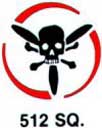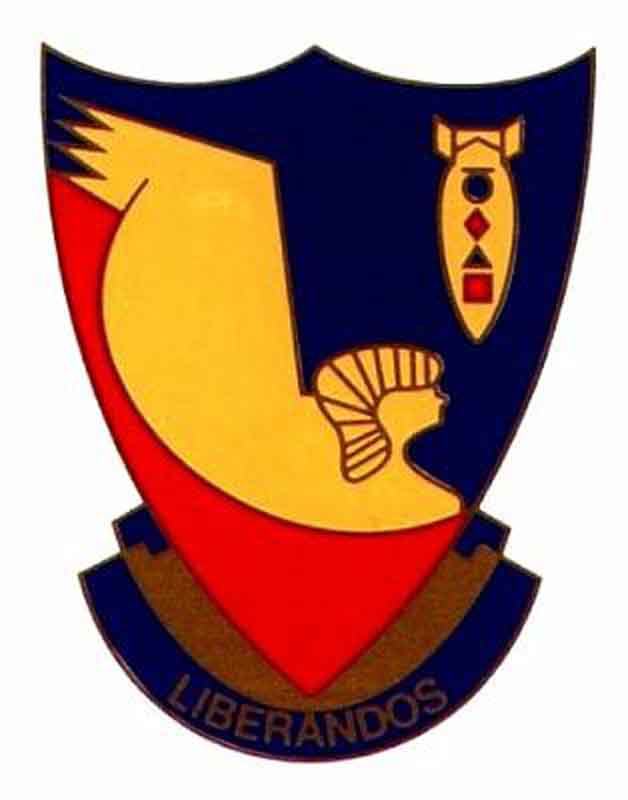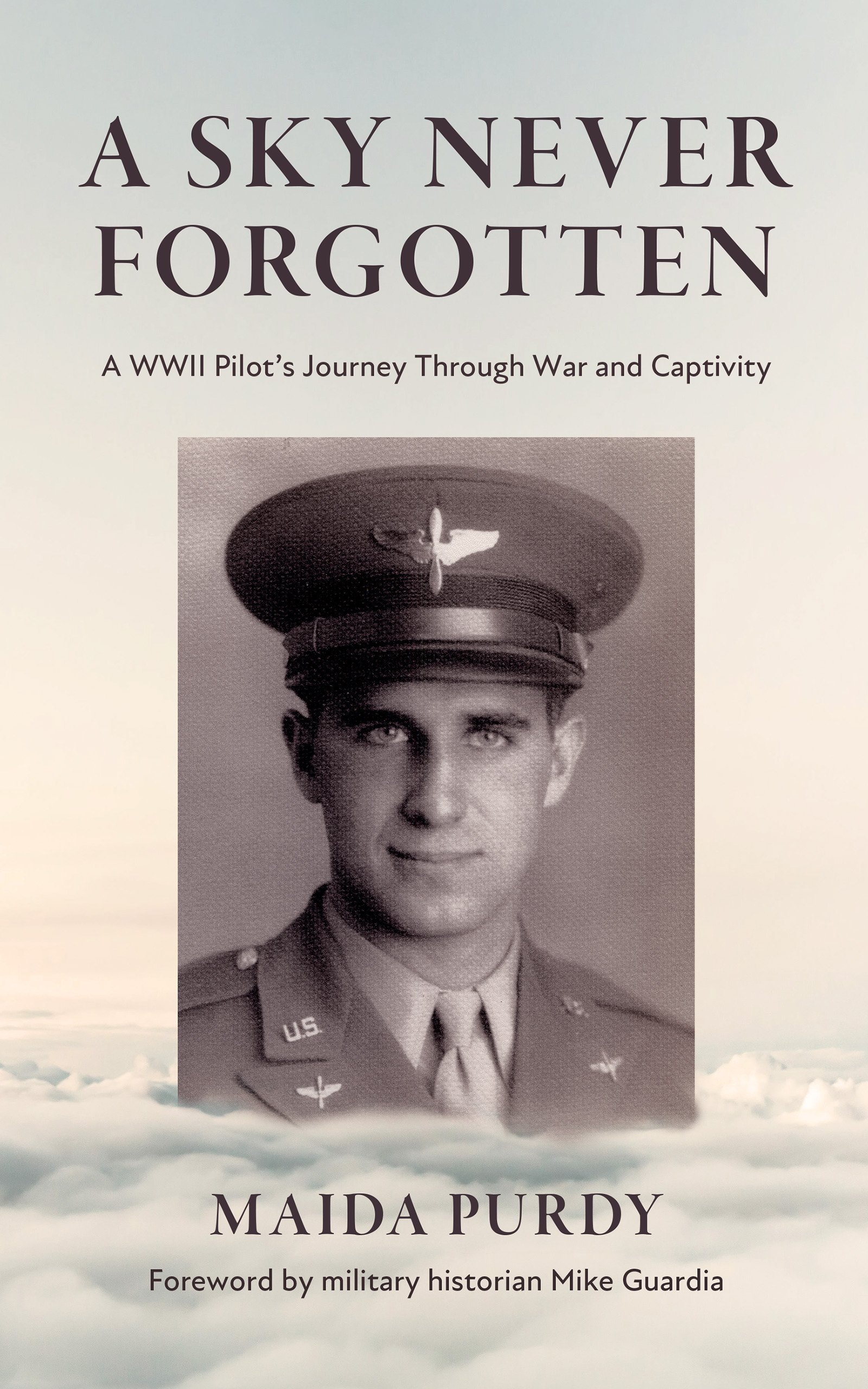Paul H. Brown, Mission December 28, 1943
Our last mission in E.T.O.
The mission that proved to be our last in the E.T.O. left our home base at San Pan at 08:40 on Dec. 28, 1943. Our target was to be the (left blank). The group was flying our usual formation with Capt. Thompson leading the group and our squadron flying the low squadron. I was flying the lead position for our squadron with Jim Collison on my right wing and Ralph Jackson on my left. Tommy Haigh was leading our second element, being flanked by Harlen Wenginger, right, and Jim Fortenberry, left. Today because of various reason we had our six best crews together to make the best job possible.
All our first pilots were an All-American, cross-section, representing almost all sections of the U.S. Jim Collison, married and father of a five month old girl, of Minneapolis, MN (43); Ralph Jackson; single and easy going "you all" boy from Louisville, KY. (40); Tommy Haigh, single and squadron big time poker player, hailing from Richmond, VA (25) - killed; Harlan Wenginger, single, tall, raw bone fellow from the farms of Blue Hill, NB. (19); Jim Fortenberry, single young, red hair, kid from Beaumont, TX (7), and myself (39).
Our gang hailed from far and wide also. Paul H. Brown, first pilot, Atlanta, GA; Arthur B. Fontaine, Co-pilot, Sacramento, CA; Charles C. Banks, Navigator, Nampa, Idaho; Arthur W. Vigneron, Bombardier, Buffalo, NY; all officers. The enlisted men were: Oscar C. Moseley, Engineer, Wachula, FL; John A. Swearingen, Asst. Engineer-Gunner, ______________ WI; Stanley Wesson, First Radioman-Upper Turret Gunner, New York City; Morton Milstein, Asst Radioman-Lower Turret Gunner, Toledo, Ohio; William T. McKenna, Tail Turret and Chief Gunner, Chattanooga, TN; and C.L. Cline, Gunner.
The mission was as usual until we got to our rendezvous point where we didn't meet our other bomber or fighter escort. As fate would have it, every time Capt. Thompson lead, the missions were in some way not go as it should. However, this being Thompson's last mission, he didn't want to have a turn back against him.
We had been briefed as to the fighter situation at and around the target, and it didn't seem to be any heavier than usual with practically nil on the flak. We had our usual accompaniment of bombers and fighters it should have been another mission, as only three days before at the same town we had suffered no losses. Our target was only sixty miles the historic and picturesque city of Venice, Italy on the Adriatic coast and seventy miles from the snow covered Alps.
As we crossed the Adriatic Coast south of Venice, and started inland the first sight of enemy fighters were reported. The Folke-Wolf· 190s, ME109s, and Machiis had climbed several thousand feet above us and were forming for the first attack. At 11:50 o'clock the first wave of fighters started to dive on us.
"Four fighters at eight o'clock" drawled Bill McKenna, Tail Gunner, in his slow steady tone, "eight fighters at five o'clock - now there are twenty and they are coming in." (The position of enemy planes are reported on the clock system, with the nose of our plane being twelve o'clock and working clockwise around the ship.) As the fighters came within gunfire range, all the guns started the steady drum of 50-calibre fire. I could feel the entire plane vibrate under the heavy fire being brought to bear on the incoming Germans. I could now see the heavy rocket shells and millimeters bursting in and around our formation. The first fighters passed so close to us that I could hear the scream of their engines over the roar of our four. The first wave had passed and we had been hit in the rear of the plane and I could feel the controls begin to get sloppy. The pass had hit us hard and I saw two fighters explode less than 100 yards from us, at the same time one of our bombers had been hit in a vulnerable spot and was beginning to burn. From then on things happened so fast it is imprinted in my memory like a quick flash of a news reel.
After the first wave had passed we had lost two planes and crews of Fortenberry and Wenzinger with the other four hit in some part. Seeing that we were hit and not able to hold our position with the formation I called each pilot and had him jettison his bomb load of 6000 lb. This being done, the ships were able to pull up a little for the last grouping before being torn to shreds by the second pass, which was now under way. The fighters, not having any Allied fighter opposition had come up with belly tanks, which will about double their gas capacity. So with what looked like a fight all the way, the gunners kept blazing away, knocking down what we later learned to be about 30 fighters. The estimated fighter opposition that day was set at 60-70.
As this wave of fighters came in, they were more and more determined to get more of us each time. "I'm hit, send someone to take my place" gasped Bill McKenna, Tail gunner. Art Fontaine, being in charge of the crew during engagements, signaled our Engineer, Oscar Moseley to start back to take over. However, we then received a vulnerable hit that set our ship on fire and into a dive, so we were never able to get to our wounded Tail-gunner. Two shell of heavy calibre, burst within three feet of the pilot and co-pilots seats - also within range of Moseley and Wisson - luckily no one except myself was hit. I felt a stinging sensation in the left ankle and knew I had received my first wound. Art Fontaine started getting up to see if we were put out of commission, and returned reporting of inside fires - just our number two engine and rudder controls gone.
I then felt the plane give a lunge like a big bird about to die. The controls were all severed and we were out of control. Up until then, as far as I know, no one had left his position, we then start signaling each man to bailout as soon as possible (our electric system was out and the warning bell would not relay the message to the various positions.) Art started out as I tried to put the plane on automatic pilot, but to no avail. I remained in my seat as long as possible to G give the others a better chance to get out. Stanley Wesson, having come down from the turret, was pulling me by the shoulder and almost pleading for me to start out. Signaling him to go out first I started what proved to be the most trying seconds of my life.
As I got out of my seat I could see Moseley trying to open the bomb bay doors, but the hydraulic system was gone. He and Wesson then started out through the nose wheel escape hatch while Art and I started to go thru the ship to go out the waist windows. Everything went well until we got to the small door leading to the rear of the ship - then, Art was wedged in the door as the plane lunged on its side and started screaming and whining on what seemed like a plunge straight down. This episode, is I believe what proved to be fatal to Arthur Fontaine. To my knowledge, Art hadn't been hit, but the next seconds the best friend and co-pilot a man could have was killed. He started on through the door as I had pushed him clear and started to the right waist window. Just then I saw Bill McKenna, who was our first man hit, coming toward us. He had by some,outstanding effort gotten from his turret and making his way to an escape Hatch. His wounds were plainly visible as he had received what looked like a direct shell burst in the chest and face. As we saw him, I started toward him to carry him to safety as best I could. But, as fate would have it, the plane rolled over and cost the lives of at least uninjured men -Fontaine, Wesson, and Moseley and at the same time I was thrown on my back and pitched from the left waist window. At the same roll, Art was thrown back into the depths of the plane and being so close to the ground he was never able to recover.
One ••• two ••• and up to ten I counted before pulling my rip cord. By then I was so close to the ground I could make out the outlines of people running to about where I would come down. With a sudden jerk the parachute opened and before I could realize it I was settling down in a very wet farm field.
By the time I loosened my chute harness and got off my life preserver I was met and attacked by one Italian. He was very belligerent and out to do me all the harm he could until two more Italians came up and pulled him off. I tried as best I could to get them to help me get away to some hide out - but to no avail. They caught me by the arms and almost carried me to a farm house about a half mile across the fields. They then tried as best they could to do what they could for the gash I had on my lip and chin. Within fifteen minutes they had SOLD me to the Germans for $14.00 - the price set on the head of all American Airmen.
After being turned over to the "Super Race", I was carried to the guard house in Vicenza. I stayed here for about an hour and was transferred to the Luftwaffe Headquarters for searching and questioning. After this was over, a German Doctor came in and gave me a very thorough examination for wounds or broken bones. Then I found that the wound I had was about the size. of a half dollar on my left ankle - however, the doctor didn't take out the shell fragment in my leg. As soon as he finished he told me something that I believe I will always remember, in "Don't worry, for you the war is over, tomorrow you will go to the Fatherland where you can rest."
Within the hour Arthur Vigneron was brought in and went through the same thing. We were then taken to the airport at Vicenza and jailed for the night. We were then given for our supper and breakfast black bread, butter and German cheese. The following morning we were taken along with eight other men to the town of Verona where we got our thorough interrogation for the duration of three days.
The morning of Dec. 30 saw us boarding a train to be taken to what the Germans called "The Fortress of Europe." All Airmen were given "priority" over other prisoners to be taken to Germany proper as soon as possible. Although under guard and in our present position we enjoyed - as much as possible - the scenery of the Alps and surrounding country. We passed through places such as Brenner Pass, Munich, Augsberg and other cities we had known only from the air.
The trip proved to be a rough one of 26 hours duration with only bread, butter and one apple and a change of trains three times. Arriving at Frankfurt we were taken immediately to solitary confinement of the "sweat-box or hotel" as it was dubbed by the prisoners.
Dec. 1943 - May1945
Lt. Paul H. Brown
Stalag I – Barth Germany


The website 376bg.org is NOT our site nor is it our endowment fund.
At the 2017 reunion, the board approved the donation of our archives to the Briscoe Center for American History, located on the University of Texas - Austin campus.
Also, the board approved a $5,000 donation to add to Ed Clendenin's $20,000 donation in the memory of his father. Together, these funds begin an endowment for the preservation of the 376 archives.
Donate directly to the 376 Endowment
To read about other endowment donation options, click here.
Reunion
NOTE change in the schedule !!
DATES: Sep 25-28, 2025
CITY:Rapid City, SD
HOTEL: Best Western Ramkota Conference Hotel; 2111 North LaCrosse St., Rapid City, SD 57702; 605-343-8500
Click here to read about the reunion details.




















